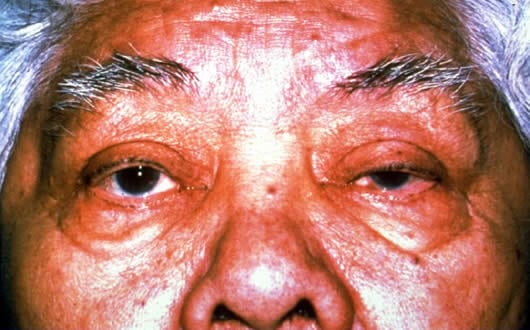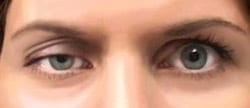Ptosis (Droopy Eyelid) Treatment in Everett, WA
What is Ptosis?

What are the Causes of Ptosis?
Ptosis is caused by an abnormality or weakness in the eyelid muscles (levator and mullers muscles). This can be congenital (occurring at birth) or acquired due to aging or neurogenic, myogenic, or mechanical reasons. In some cases, it may simply be caused by loose skin on the upper eyelid.Sometimes, however, the reason behind a case of Ptosis is more troubling. In addition to the possibility of the disorder occurring as a congenital condition, or as a consequence of an injury or surgery, Ptosis may be caused by:
- Migraine headache
- Growth in the eyelid, such as a stye
- Bell’s Palsy
- Diabetes
- Stroke
- Myasthenia gravis
- Horner syndrome
- Benign or malignant tumor
In rare instances, Ptosis can occur due to a brain tumor or other malignancy that affects the reactions of muscles or nerves.
The Symptoms of Ptosis
Ptosis presents as the drooping of one or both eyelids, and is sometimes accompanied by one or more of the following symptoms:
- Increased tear production
- Difficulty blinking or closing the eye
- Reduced vision (with severe drooping)
Since Ptosis caused by aging is usually gradual, a sudden onset of symptoms is a greater cause for concern. If you are concerned you may be experiencing symptoms, please call Physicians Eye Clinic today to schedule an appointment.
FAQs
Does Ptosis Require Treatment?
If you have eyelid drooping that is mild and does not cause significant concern related to your appearance, vision, or eyelid function, you don't have to rush to receive treatment for your condition. In the instance of vision obstruction, the surgical correction of the drooping eyelid may be the most advantageous choice. It allows you to regain a full visual field, increasing personal safety and quality of life.
Is Blepharoplasty the Right Treatment for Ptosis?
Blepharoplasty is the most common eyelid surgery that is known today. It has been popular for many years for its ability to correct age-related eyelid drooping, hooding, and puffiness (bags). These conditions make the eyes appear aged and tired. In the case of upper eyelid drooping, there is also the potential for vision obstruction if the loose skin sags down over the eyelashes into the visual field. During the blepharoplasty procedure, the surgeon trims away excess skin and tissue and may redistribute fat. This results in smoother, more youthful-looking eyes.
Ptosis may be caused by age-related changes in the skin and superficial tissue. However, many cases of ptosis lie with the levator muscle in the upper eyelid. In some instances, there is a combination of the two separate tissue problems. The levator muscle in the upper eyelid is responsible for raising the eyelid and also holding the eyelid in place. A stretched or elongated levator muscle allows the eyelid to sit lower on the globe of the eye. This is why a person with ptosis may look like the affected eye is partially closed. In order to correct ptosis in the best way, your doctor must perform a thorough examination of your eyelids and determine which structure requires modification.
Does Insurance Cover Ptosis Treatment?
Generally, drooping eyelids are perceived to be a cosmetic problem that originates with tissue changes that occur with age. Therefore, the correction of the sagging eyelids is done primarily for cosmetic improvements. Insurance companies typically do not provide coverage for cosmetic procedures because they are considered elective; they're not necessary. To receive insurance coverage for a ptosis-related surgical procedure, your first step would be to contact your insurance provider. Your insurance company can discuss what information they require, if any, to evaluate your case for medical necessity. Some of the information that may be requested includes:
- Physician notes that clearly document the position of the eyelids.
- Picture documentation of the eyelids and eyes that shows extra tissue obstructing the visual field.
- A Visual Field Test may be required to provide a measurement of vision impaction.
Additional tests may be requested to further evaluate whether or not ptosis treatment is medically necessary. Finding out what your insurance provider requires should be as easy as making a phone call! With that, you can receive specific plan details, including the percentage of coverage that may be available to you.
Does Ptosis Get Worse?
Drooping of the eyelid may remain consistent for many years. There are several factors that may influence the progression of this condition, including your general health, lifestyle, and genetics. It's difficult to say that ptosis won't get worse over time. Likewise, we cannot say that it will. Fortunately, the treatments for ptosis are minimally-invasive and effective. Should you reach a point at which your vision is adversely affected by ptosis, you can take steps to correct the issue right away. Just give our office a call! We're here to help you understand how you can regain optimal vision and appearance as quickly as possible.
How is Ptosis Diagnosed?

If there is a suspicion of an underlying systemic disease, the patient will be referred to an internist or other physicians for further investigation prior to treatment.
Droopy Eye Treatment
Treatment depends on the type of Ptosis you have. The most common type is age-related, which requires that the levator muscles are repaired in order to raise the upper lid.
Patients may seek treatment for droopy eyelids for cosmetic or medical purposes. Severe drooping may obstruct vision as the eyelid gradually droops lower and lower, eventually covering the eye. If Ptosis interferes with a patient’s vision, a Blepharoplasty will be performed to eliminate the drooping. Many young patients with mild to moderate cases should be examined regularly to check for other vision problems including amblyopia, refractive errors and muscular diseases.
How Does Droopy Eye Treatment Help Sagging Eyes?
At the time of the eyelid surgery, any excess skin is excised, which makes the eyes not look as saggy anymore. Contact Physicians Eye Clinic today for more information or to schedule a consultation.
Schedule a Consultation

